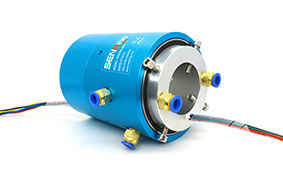What would be the effect of using a slip ring instead of a split ring commutator?
Using a slip ring instead of a through hole slip ring electrical commutator would have several effects on the performance and operation of an electric motor:Reduced Efficiency: Slip rings are typically less efficient than split ring commutators because they have more friction and electrical resistance.
This can result in increased heat generation and energy loss, reducing the overall efficiency of the motor.
Increased Maintenance: Slip rings require more frequent maintenance compared to split ring commutators due to wear and tear caused by friction.
The brushes that ride on the slip rings may need to be replaced more often, leading to higher maintenance costs.
Reduced Commutation Performance: Split ring commutators provide better commutation performance by effectively reversing the current direction
in the armature coils as they pass under the brushes. Slip rings, on the other hand, may not reverse the current as effectively, leading to poorer
commutation and possible sparking at the brushes.

Increased Cost: Slip rings are generally more expensive to manufacture and install compared to split ring commutators. This can increase the overall cost of the motor.
In summary, using a slip ring instead of a split ring commutator can result in reduced efficiency, increased maintenance, poorer commutation performance,
higher costs, and limited applicability.
Using a slip ring instead of a split ring commutator in an electric motor would lead to significant changes in the motor's operation and performance. Here are some
key effects of using a slip ring instead of a split ring commutator:

Impact on Torque: The absence of a split ring commutator and its function in reversing current would result in a loss of the motor's ability to generate continuous torque,
severely impacting its operational effectiveness, especially in maintaining a consistent rotational direction.
Motor Operation and Control:
Speed Control: A split ring commutator allows for precise control of the motor speed and direction by controlling the timing of current flow through the rotor windings.
Without this feature, the ability to effectively control the motor's speed and direction would be compromised.
Starting Performance: The absence of a split ring commutator would affect the motor's starting performance, making it more challenging to initiate smooth and controlled
rotation, potentially leading to increased mechanical stress during start-up.
Overall Efficiency and Reliability:
Efficiency Considerations: The use of a split ring commutator enables efficient and reliable operation by ensuring that the motor can produce continuous torque and
maintain consistent rotational direction. Without this functionality, the motor's overall efficiency and reliability would be compromised.
Mechanical Stress: Without the proper means to reverse current flow and control torque, the motor's mechanical components, such as the brushes and windings, could
experience increased stress, potentially leading to premature wear and reduced operational lifespan.
In summary, substituting a split ring commutator with a conductive slip ring in a DC motor would fundamentally alter the motor's ability to produce continuous torque,
control speed,and maintain reliable operation, resulting in compromised performance and operational challenges. Therefore, the choice between a split ring commutator
and a slip ring should align with the specific requirements of the motor's intended application and the need for precise control, continuous torque production, and reliable
operation.
For more details on slip ring products, please view :https://www.senring.com/info/industry/2024-01-26/119.html
FAQ questions:
1.What does a high rating slip ring induction motor use?
2.Are Industrial Bus slip rings usually made of copper?
3.What are the drawbacks of slip rings and carbon brushes?
4.What are the purpose of slp ings on rotor?
5.What is capsule slip ring and is used for?

 RESOURCES
RESOURCES GET A QUOTE
GET A QUOTE





